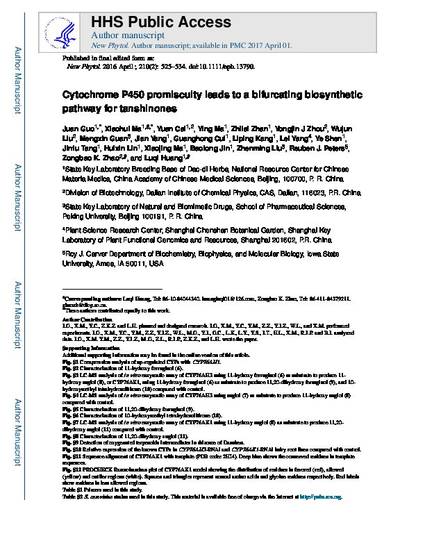
Cytochromes P450 (CYPs) play key role in generating the structural diversity of terpenoids, the largest group of plant natural products. However, functional characterization of CYPs has been challenging because of the expansive families found in plant genomes, diverse reactivity and inaccessibility of their substrates and products.
• Here we present the characterization of two CYPs, CYP76AH3 and CYP76AK1, that act sequentially to form a bifurcating pathway for the biosynthesis of tanshinones, the oxygenated diterpenoids from the Chinese medicinal plant Danshen.
• These CYPs had similar transcription profiles to that of the known gene responsible for tanshinone production in elicited Danshen hairy roots. Biochemical and RNA interference studies demonstrated that both CYPs are promiscuous. CYP76AH3 oxidizes ferruginol at two different carbon centers, and CYP76AK1 hydroxylates C-20 of two of the resulting intermediates. Together, these convert ferruginol into 11,20-dihydroxy ferruginol and 11,20-dihydroxy sugiol en route to tanshinones. Moreover, we demonstrate the utility of these CYPs by engineering yeast for heterologous production of six oxygenated diterpenoids, which in turn enabled structural characterization of three novel compounds produced by CYP-mediated oxidation.
• Our results highlight the incorporation of multiple CYPs in diterpenoids metabolic engineering, and a continuing trend of CYPs promiscuity generating complex networks in terpenoid biosynthesis.
Available at: http://works.bepress.com/reuben_peters/68/

This is the peer reviewed version of the following article: Guo, J., Ma, X., Cai, Y., Ma, Y., Zhan, Z., Zhou, Y. J., Liu, W., Guan, M., Yang, J., Cui, G., Kang, L., Yang, L., Shen, Y., Tang, J., Lin, H., Ma, X., Jin, B., Liu, Z., Peters, R. J., Zhao, Z. K. and Huang, L. (2016), Cytochrome P450 promiscuity leads to a bifurcating biosynthetic pathway for tanshinones. New Phytol, 210: 525–534, which has been published in final form at doi:10.1111/nph.13790. This article may be used for non-commercial purposes in accordance With Wiley Terms and Conditions for self-archiving.